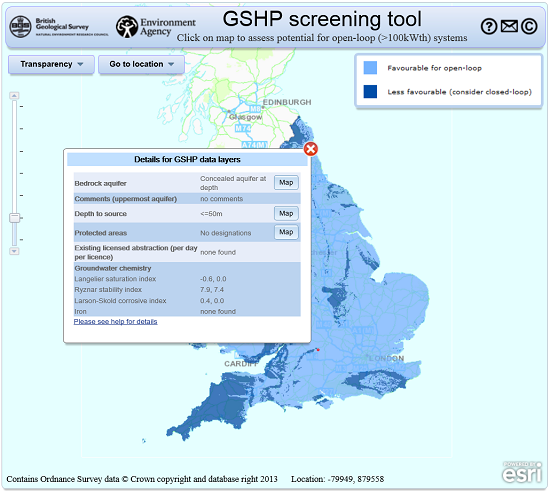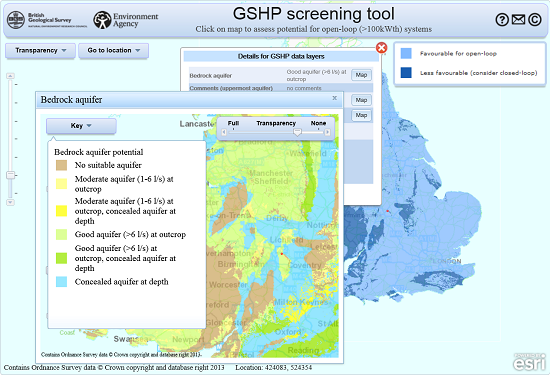The challenge
The government roadmap for achieving national targets of 15% renewable energy by 2020 implies that about 6% of this target will be from non-domestic ground source heat pump installations. This corresponds to a 30-fold increase in installed capacity of heat pumps for the UK. Large scale open-loop ground source heat pumps (GSHPs), can be more economical than closed-loop systems, and could make a substantial contribution to this goal.
However, the uptake of these systems is often hindered by the perception of risks associated with unknown hydrogeological and economic conditions.
The solution
To increase confidence at the early planning stage and to encourage the uptake of open-loop GSHP technology, the British Geological Survey (BGS), in collaboration with the Environment Agency, have developed a web-based screening tool that gives planners and developers an indication of the depth, productivity and quality of potential aquifers that exist in a given area. Using the BGS national-scale data sets and its extensive knowledge of the UK’s hydrogeology, the tool maps the conditions for open-loop GSHP installations (heating/cooling output >100kWth) in England and Wales at the 1:250,000 scale.
The BGS team has worked in close consultation with experts from the GHSP industry (ESI, Anglian Water, Carbon Zero Consulting) and are using the most relevant hydrogeological and economic parameters, including productivity of the aquifer and depth to the source, as well as locations of protected areas. Where data are available, the screening tool also provides information on the scaling/corrosion potential, iron concentrations and abstractions within a search radius around the location of interest. Data are collated, grouped and summarised within a GIS environment and suitability for GSHPs is displayed in the form of a map and tables.
The tool is available on the BGS website.


Resulting benefits
The GHSP screening tool provides an initial assessment of suitability of a specific location/area, and can also be used for resource-planning at the county, regional or national scale. For example, a pilot study has shown that conditions in >50% of the West Midlands area of England are favourable for open-loop schemes of commercial size.
John Findlay, Director of Carbon Zero Consulting, said “This new tool will be useful for identifying viable open loop locations at an early project stage. More generally the tool shows that favourable conditions for the installation and running of open-loop systems exist in large parts of the country”.
Future directions
The tool supports renewable assessments and target setting for the shallow geothermal resource. More importantly, it shows that GSHP technology is applicable in large parts (69%) of England and Wales, hence promoting and encouraging uptake of more sustainable heating/cooling technologies in the UK.
Ground source heat pumps: development of GeoReports for potential site characterization. Carbon Trust R&D project, Commissioned Report CR/05/217N
A screening tool for open-loop ground source heat pump schemes (England and Wales) BGS Energy Sciences Programme Open Report OR/12/064
Customer:


Sources of funding
BGS and EA - National Capability Funding (BGS for 2 years, EA for 1 year)






















 The Water Security Knowledge Exchange Portal supports the objectives of the
The Water Security Knowledge Exchange Portal supports the objectives of the 